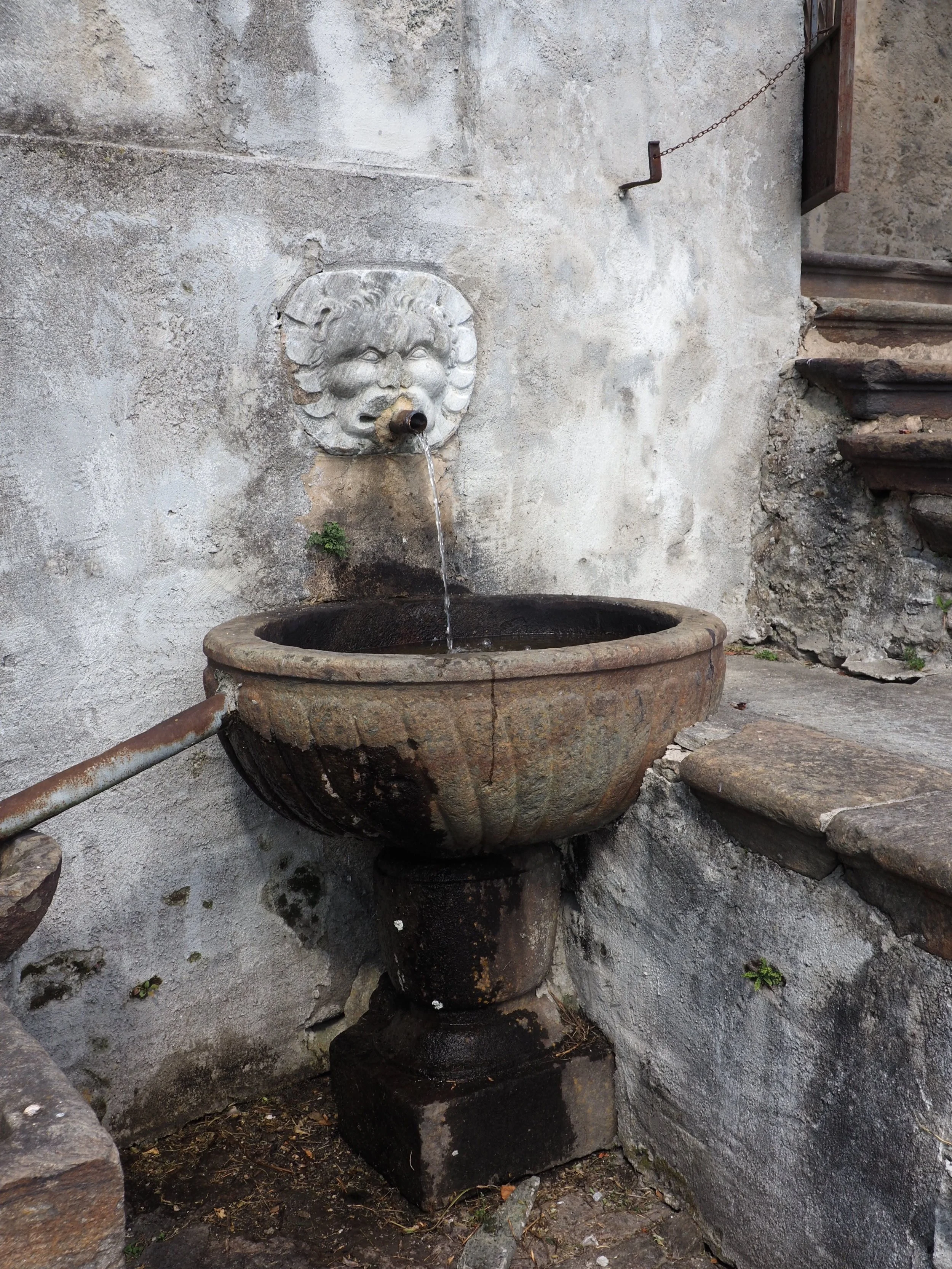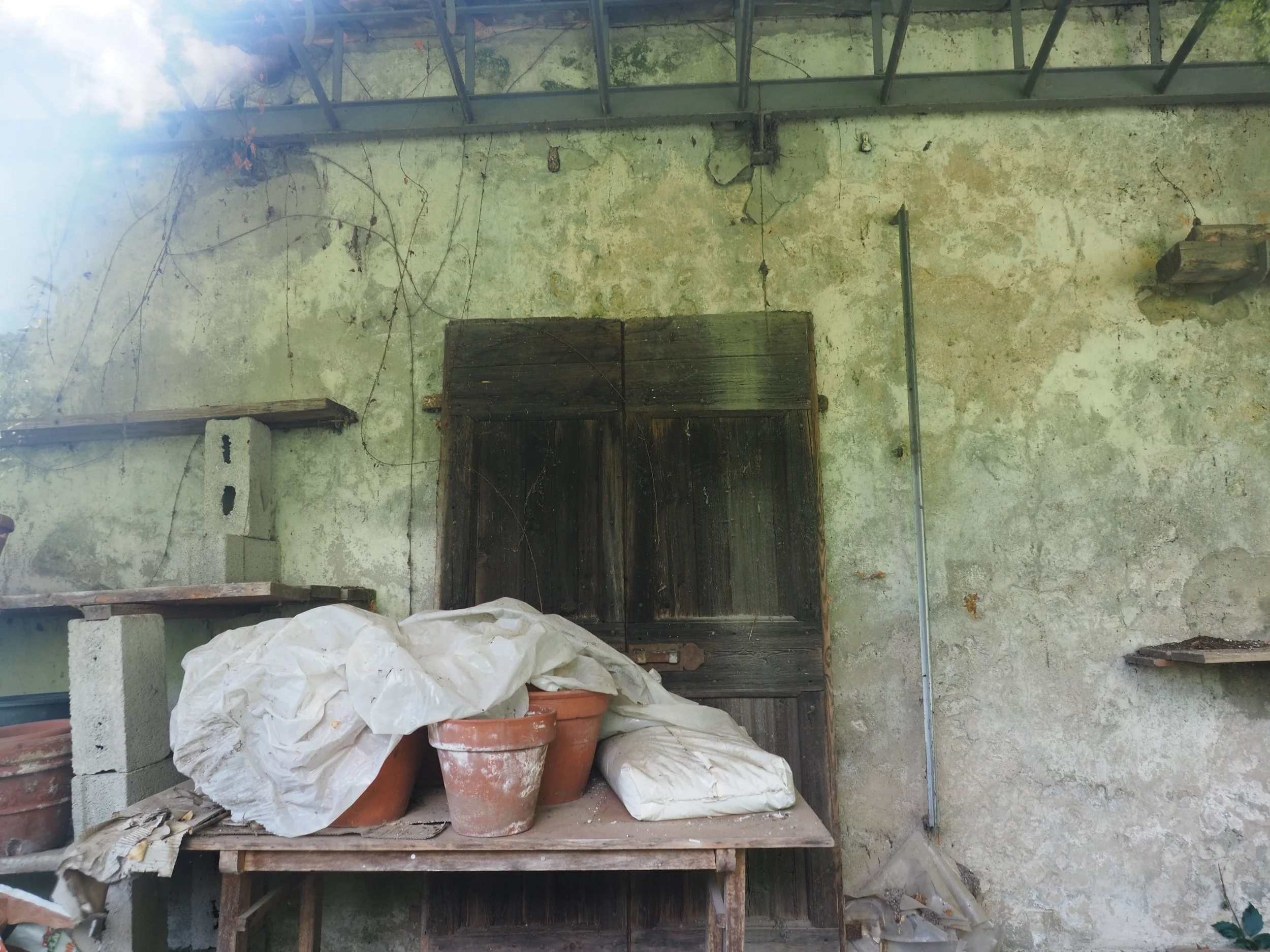In Italy, near the Swiss border, and 16km north of Lake Como, is a town called Chiavenna. The town has been built on flat land on either side of the river Mera. It’s surrounded by rocks and mountains and forests.
The river Mera, Chiavenna, Italy, June 2018.
Chiavenna used to be an important crossing point back in ancient Roman times. It’s also the end of the Via Spluga trail, an old trading route dating back centuries. The trail is a series of bridal paths that start (or end depending on which direction you’re travelling) in Thusis, Switzerland.
My family and I were supposed to arrive in Chiavenna by foot, walking the Via Spluga from Isola. But we didn't. My husband had a broken elbow and I hated walking along the edge of cliffs. Our walking notes suggested that we’d need to do some scrambling over rocks high above the river Liro. We opted for public transport instead.
The bus ride from Isola was an adventure in itself. The roads were steep, narrow and twisting with many a hairpin bend. My enduring memory is the bus speeding through lots of tunnels and the deafening honking of the horn. The tunnels were windy and only wide enough for one vehicle, which is why the driver sat on the horn. Windows had been cut into sides of the tunnel to let in the light. I'd catch glimpses of the river way way below us and the roofs of houses perched on the cliff edge. It seemed incredible to me that towns and villages grew up in such wild steep places..
The river Mera, Chiavenna, Italy, June 2018.
The river Mera, Chiavenna, Italy, June 2018.
Chiavenna, Italy, June 2018.
It was a scorching hot day when we arrived in Chiavenna. It was the sort of hot that made you shelter in the shadows and lust after cold places like Antartica and the North Pole. We would’ve loved to have spent the whole time in our air conditioned hotel room, but we knew we’d regret it. We were only staying for 2 nights in Chiavenna and chances were we’d never pass this way again. We had to make the most of the pretty medieval town centre, the jaw-droppingly beautiful landscape and quiet devoid-of-tourists streets. Chiavenna felt real. Besides, there was a renaissance palace and garden that I had to see.
The palace was a 2km walk from the centre of Chiavenna. Most of it was on a footpath by the river. We passed shops and squares, and a church built into the cliffside, and lots of stone drinking-fountains (with cool bubbling spring water). Then we crossed the river and zigzagged up quiet ordinary suburban streets. Passing suburban gardens and barking dogs and arrived (after many wrong turns and cross words) at the nondescript palace gates.
A suburban back garden near the palace.
Palazzo Vertemate Franchi sits on a hillside with views of the mountains and Chiavenna. Palazzo Vertemate Franchi is a Renaissance house and garden, which survived a terrible landslide and flood in 1618 that wiped out parts of the town. It was built by two wealthy brothers, Guglielmo and Luigi Vertemate Franchi in the late 1500s.
In the interests of family harmony I suggested that we only visit the garden. It was an hour before closing, and as much as I really wanted to see the inside of a renaissance house (and the frescos painted on the walls), I wanted to see the garden more. My son announced, in a voice that dared me to disagree, that I’d better hurry up and take my garden photos cause we wouldn't be staying long. Little did he know!
The garden surrounding the palace had a flower garden, a chestnut wood, an orchard, a vineyard, and a fishpond with a double exedra-shaped banister (whatever that is). It is a typical Italian renaissance garden. The Villa d'Este at Tivoli it wasn't, but it was plenty grand enough for me. As it turned out, I fell in love with its authenticness and lack of polish.
Palazzo Vertemate Franchi, Chiavenna, June 2018.
Before there were renaissance gardens there were medieval ones. These were functional simple gardens preoccupied with growing useful plants for eating and healing. These gardens were surrounded by high walls and the garden beds were often square and bordered by plants. I'm telling you this so that you get an idea how big the leap was from medieval gardens to renaissance ones.
The Renaissance garden was a garden that was designed to impress. Sure, it produced useful crops but it also had to be beautiful in a pared-back classical Roman sort of way. Back in the fifteenth and sixteenth centuries ancient Greek and Roman art, architecture and gardens were all the rage. Think symmetry, axial geometry, balance and order. Think porticos, columns, statues, vases, water features and evenly placed trees. The renaissance garden designer wanted to impose order over nature. The people were in charge.
The ideal renaissance house was placed on a hill that was gently terraced, with linking paths and steps. The garden could be seen from every window of the house and the house could be seen from the garden. The entire garden was divided into compartments or garden rooms with walls. These were gardens to be walked in, to entertain and surprise. The walls surrounding the garden rooms could be solid, stone or hedges, or they could have gaps, a row of columns or a pergola or a portico. Climbing plants were trained to clamber and drape themselves over all vertical surfaces.
Palazzo Vertemate Franchi, like other renaissance gardens has a central axis. You can see it in the 2 photos above. It runs in a straight line from the front door, down the steps, across the courtyard, down a second set of steps, along the path through the flower garden and up to the low wall around the vineyard. The line continues, invisibly, across the roofs of Chiavenna and between the mountains.
I'm guessing here, but the square beds are probably planted with similar plants that were used in the fifteenth and sixteenth century. Everything would've been planted in rows, as it is in the photographs.
I don't like the black plastic weed matting. Maybe there's a good reason for it, but it's ugly. Perhaps there's only one or two gardeners employed and the matting is used to reduce the labour costs. After all there's a lot of garden areas to look after. Maybe the weed matting keeps the moisture in. Maybe it's the latest greatest development in environmental technology - What do I know?
The archway in the wall and the tall slender tree are a mirror image of the archway and tree at the opposite end of the flower garden.
The photo above, with the tall tree and archway is the mirror image of the picture I was talking about 3 photos up.
Renaissance gardens had archways and used lots of climbing plants such as ivy, roses, honeysuckle and grapes.
You can just make out the stone gutter around the raised bed on the right. It's use (and I'm guessing here) is to transport water.
The texture combination of the rough stone wall, the handmade trellis, the fresh green grape leaves with twisting vines and the lush rosemary (which you can almost smell) are simple and perfect.
The trellis consists of thin pieces of wood that are tied together.
The opening is linked to the stone gutter. It must've been used to irrigate the gardens. I know that Erigeron or fleabane daisy is considered a weed in New Zealand but there’s no denying its charm in the photo above.
Here's a closeup of the wood trellis, the grape vine and a couple of fennel plants.
This simple water fountain, with classical statuary, is a feature of a renaissance garden. it's also where we filled our water bottles.
Here is a closeup of the front steps of the palace.
This is the courtyard to the left of the front door.
Here is a detail of the cobbles.
Here is a fish pond with the double exedra-shaped banister. There is another courtyard to the right of it.
This is the courtyard to the right of the fish pond. A door from the palace opens onto it. Terracotta pots, often decorated like the ones above, were a feature of renaissance gardens.
The courtyard with the statue opens onto the orchard. Here is another axis, a path flanked by roses. It leads to a stone wall, an alcove and a statue.
Here is a view of the palace from the orchard. Notice the wall on the left. Each section of the garden is surrounded by walls.
The path runs in a straight line from the side door in the palace to the statue.
This is the potting shed.
Here is a closer look at the sculpture in the orchard.
This is the courtyard beside the fishpond. You can see the door of the palace opening onto it.
At the back of the palace is the chestnut forest.
Star jasmine Jasminium multiflorum draped itself over many walls. The scent was very sweet in the hot sun.
Here are some hedges and simple topiary in the courtyard beside the fish pond.
We are back in the courtyard by the front door, looking towards the flower garden.
This climber reminds me of a vine that grows widely in Auckland, called trumpet vine Campsis. I don't know if this is the same plant. I don't remember the trumpet vine having such a sturdy trunk, but maybe this is what you get when you train a climber up a pillar.
The gnarled trunks of many of the vines has a sculptural quality.
The garden at Palazzo Vertemate Franchi has aged gracefully. On the day we visited we more or less had the place to ourselves. It’s easier to get the true feel of a garden when it’s empty of people. It’s just the plants, the buildings, the landscape and the light.
I came away from my visit to Palazzo Vertemate Franchi with a few ideas. I want to experiment making gardens using more foliage plants. I want to use more rosemary and star jasmine. I want to explore what a NZ renaissance garden might look like. Not some cheesy Roman knock-off but an attempt at using simple plants and local materials honestly.
Tree planting in my local forest.
I haven’t done any gardening in my own garden for a couple of weeks. For the last two weekends (when I'd usually be out in the garden) I’ve been tree planting in my local forest. Last weekend my husband gave me a hand. We’re trying to re-forest the forest which has many canopy gaps and clearings from years of neglect and abuse.
Burt Reynolds died last Thursday. What does he have to do with a garden blog? Absolutely nothing. But he was part of the wallpaper of my childhood and for that reason he deserves a mention. Burt Reynolds was a smiling version of The Marlboro Man, who is also dead (he died of lung cancer). Both of them represented my ideal man (this is the 70s remember and I was a 10 year old living in the Waikato - beef and horse country). Back then my ideal man was a modern cowboy who drove a Valiant Charger. Thank god I grew up. According to the obituary in the paper, Burt was a difficult man. He had a troubled personal life and a career with high highs and a lot of lows. Burt died at the age of 82 from a heart attack. Moral of the story: show business is bad for your health and bad for your love life - stick to gardening.




































































































